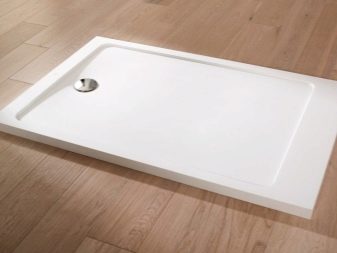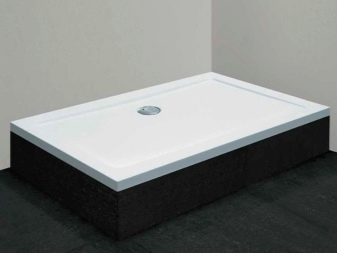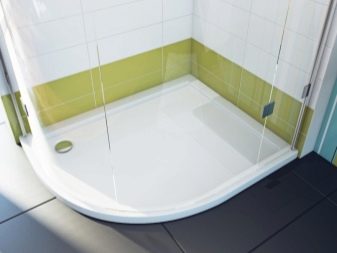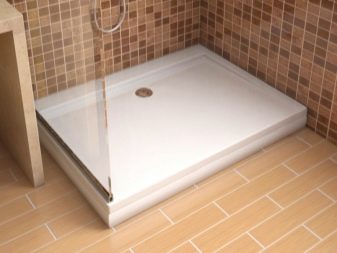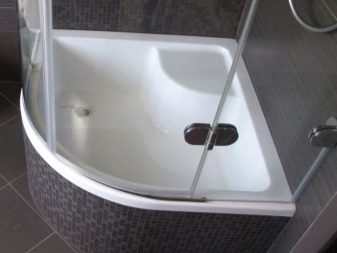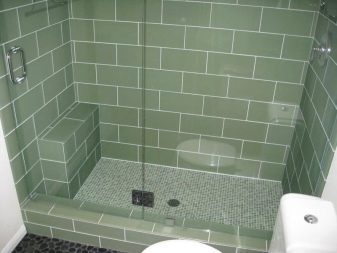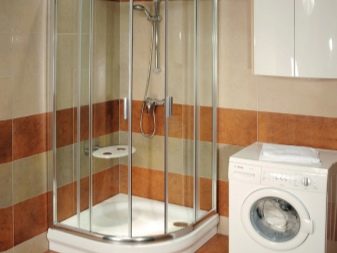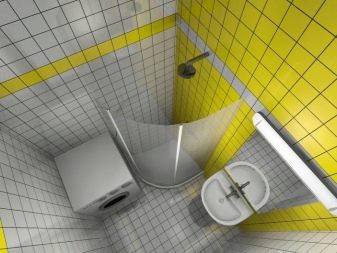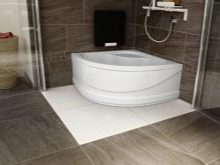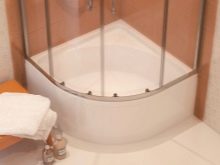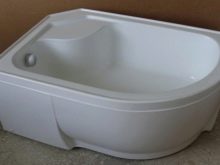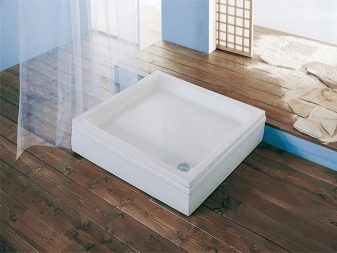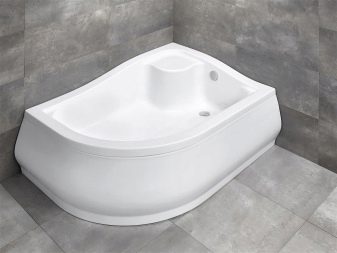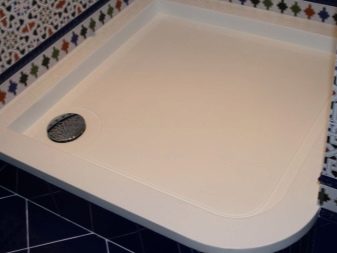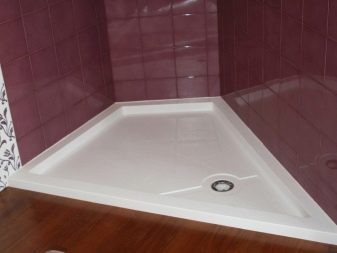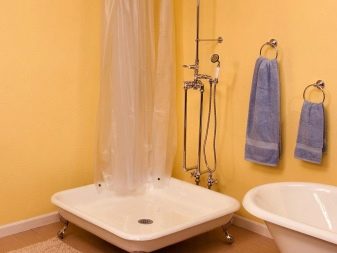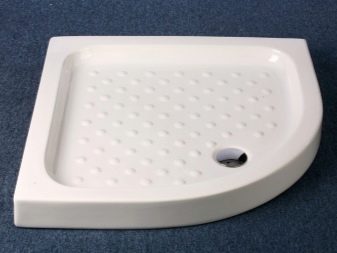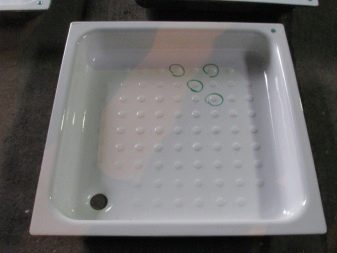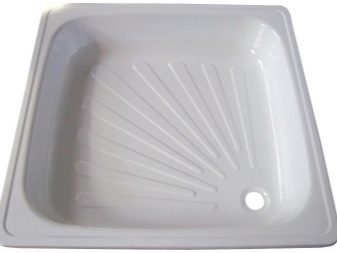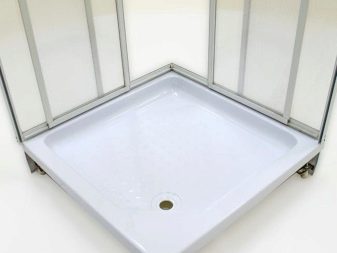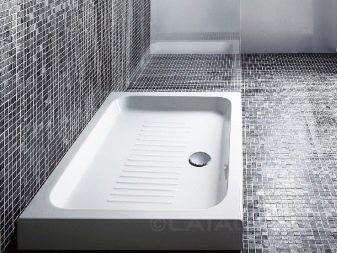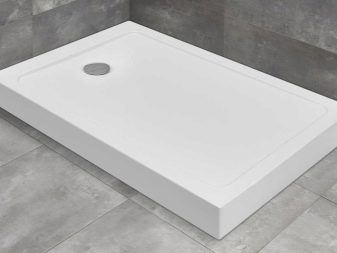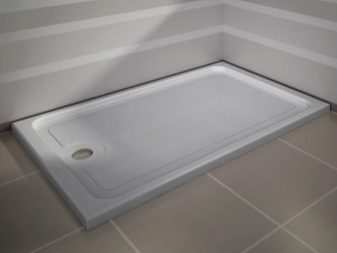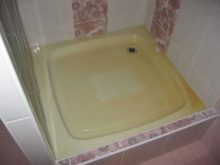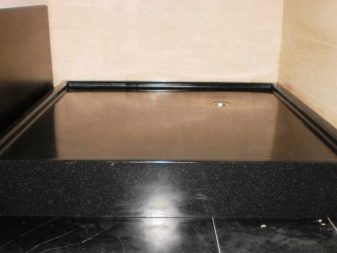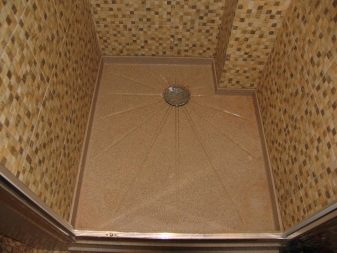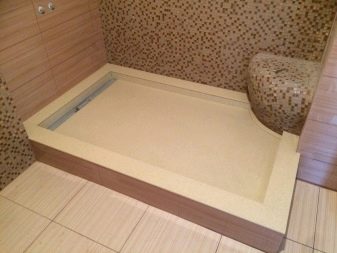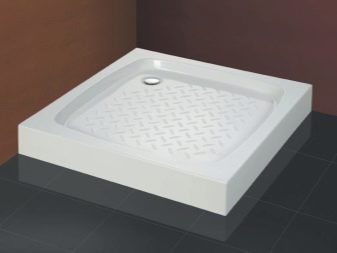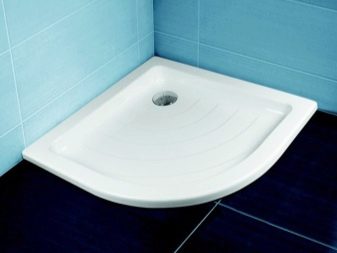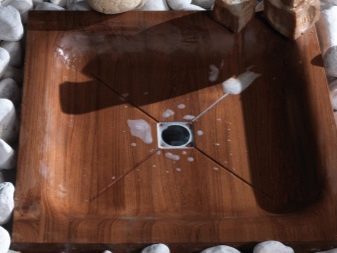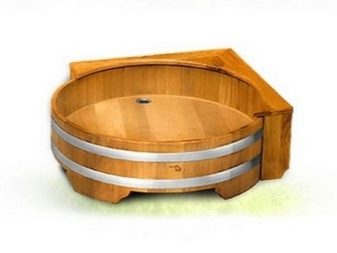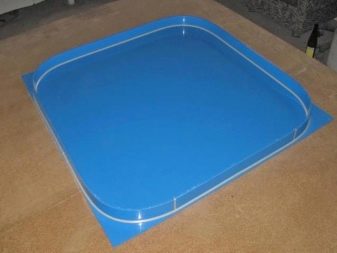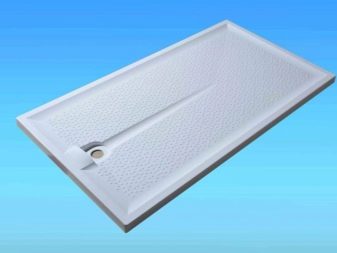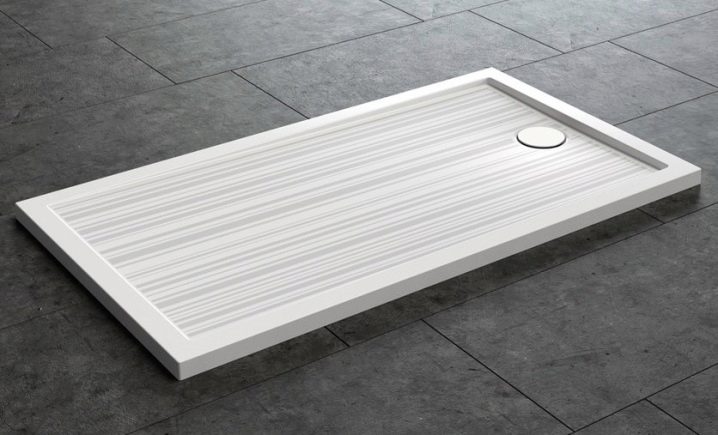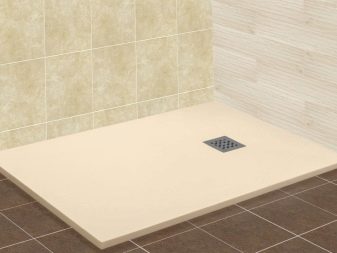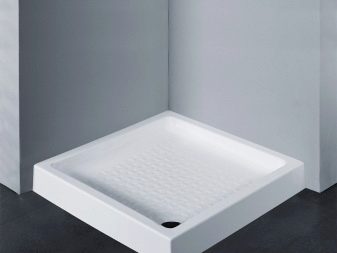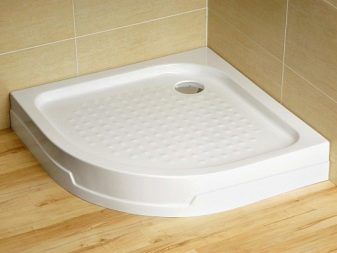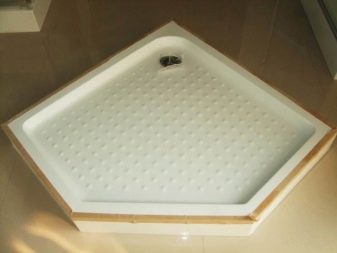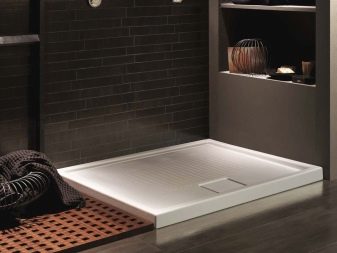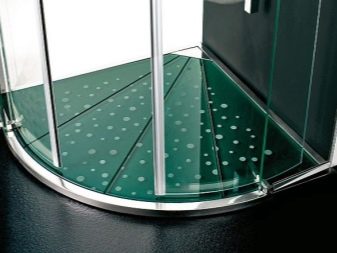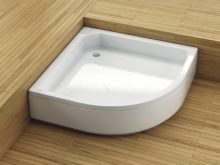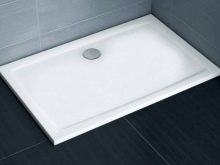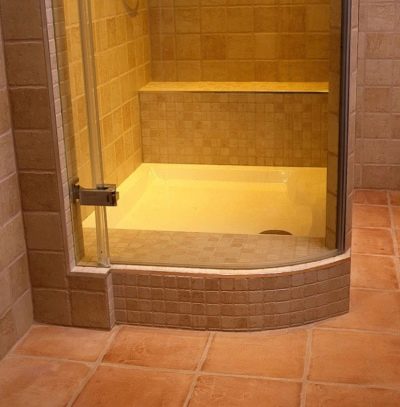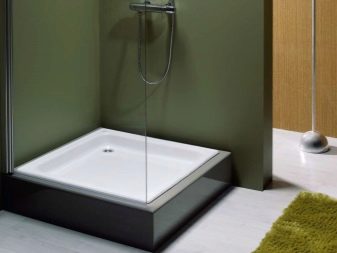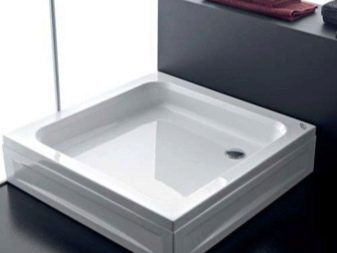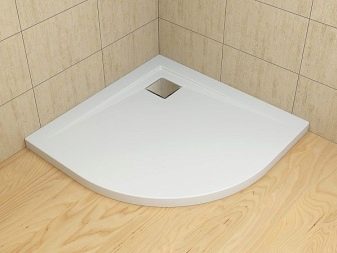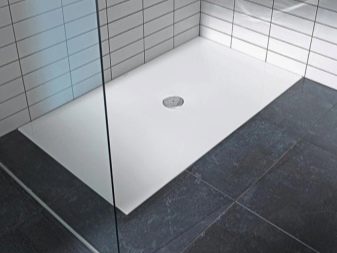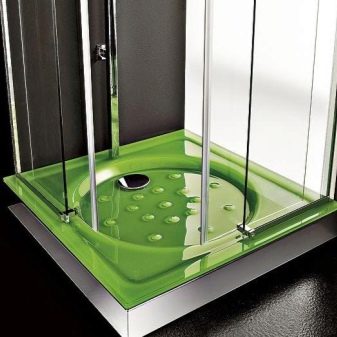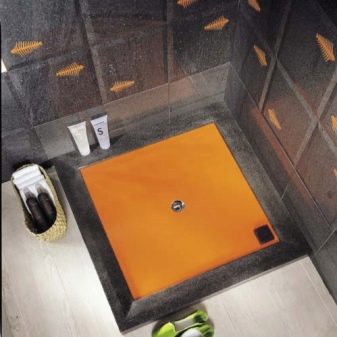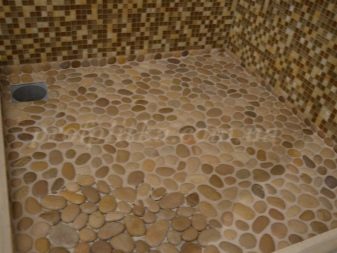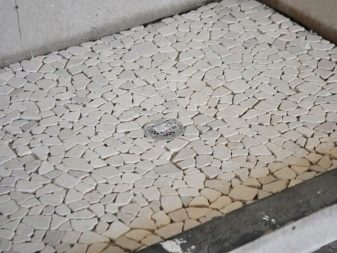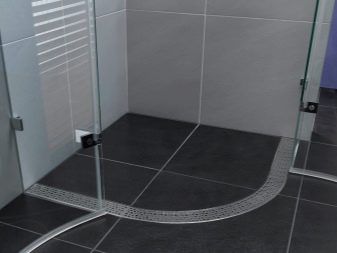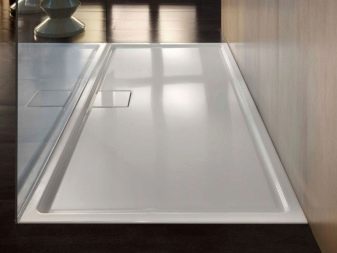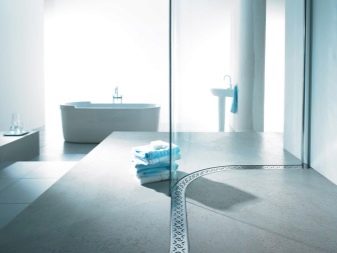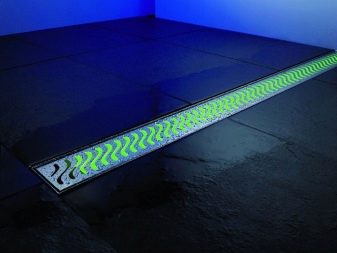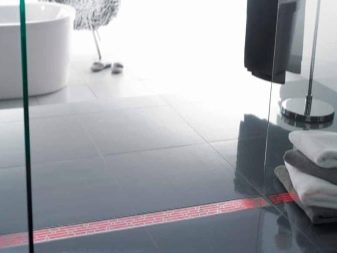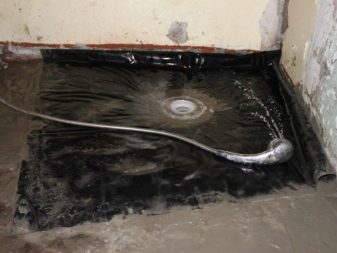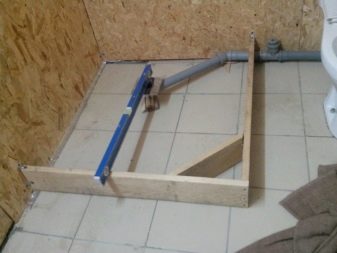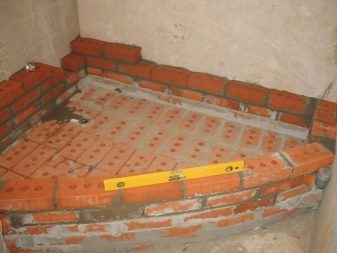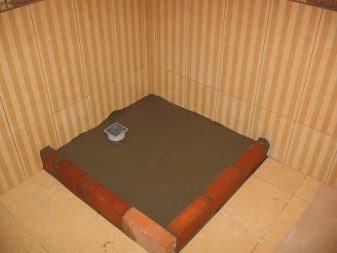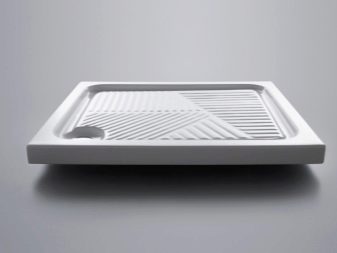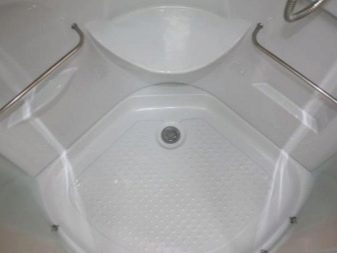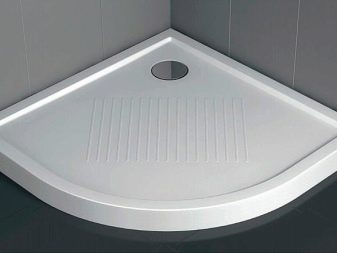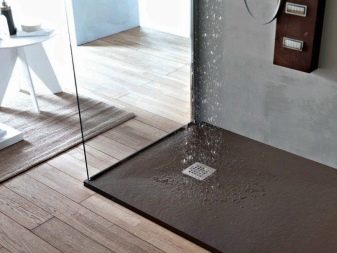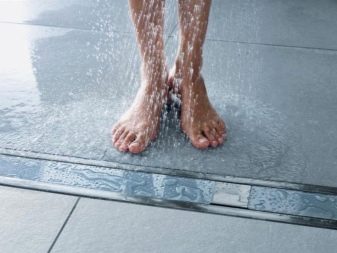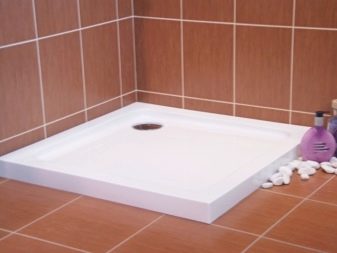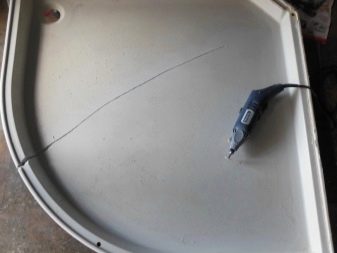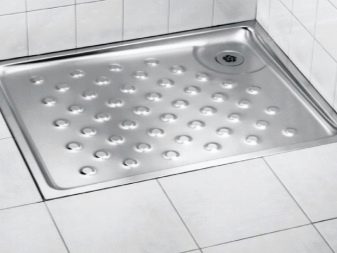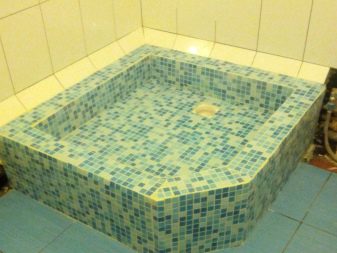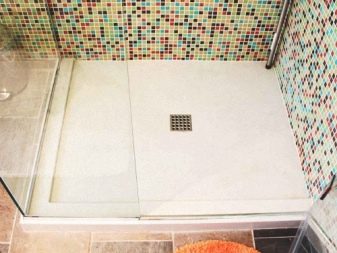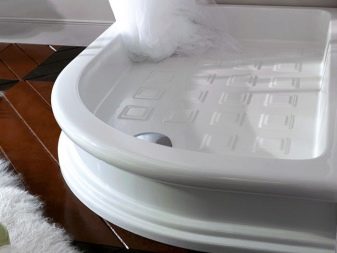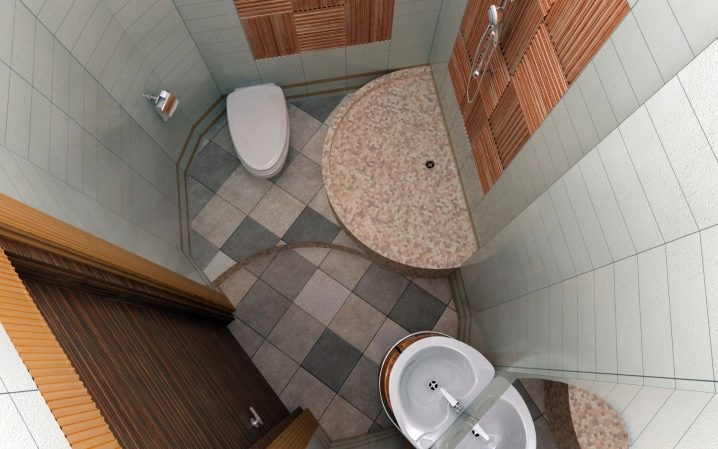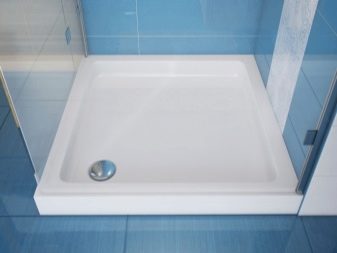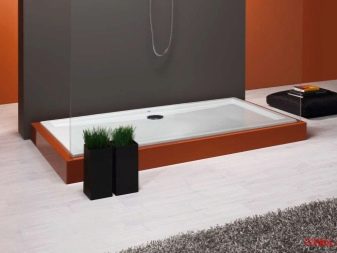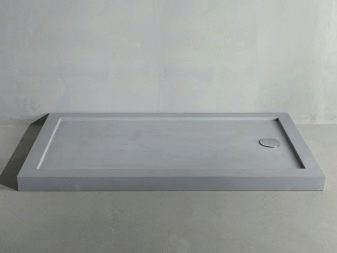Shower trays: features of choice
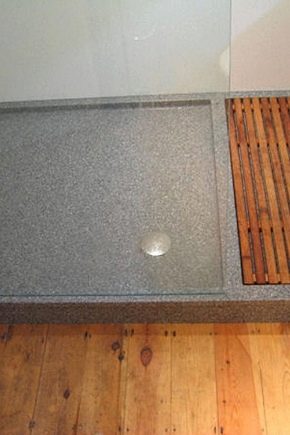
The modern market offers the broadest selection of shower stalls and individual pallets, which differ in the variety of shapes, materials used, designs and colors.
Features and Purpose
Shower tray trays are a universal element of the wash zones. They can be both a part of the hydrobox and a separate construction.
The main task of the pallet is to protect the flooring and walls from beating jets of water and wet splashes flying in all directions.
Thanks to the pallets, the decorative elements of the bathroom are protected from the adverse effects of moisture and premature destruction.In addition, pallets prevent water from flowing into the baseboard and the joints between the walls and the floor, so that the mold does not develop and fungi do not appear.
The pallet performs several important functions:
- collects and discharges running water;
- acts as a “foundation” for mounting shower enclosures;
- used as a link between the walls and doors of hydrobox;
- eliminates excessive load on the drain structure in the shower;
- makes hygiene procedures comfortable and safe;
- It acts instead of a heat insulator, protecting a person’s feet from a cold concrete floor.
The main advantage of pallets is that they can be installed even in a small-sized bathroom, allowing you to significantly improve the ergonomics of the sanitary zone of an apartment or house.
Today, the stores have a large selection of models of a wide variety of shapes, colors and textures, while the price run is also quite wide, so everyone can choose a model based on their own taste and the available budget.
Device design
The complete set of the shower tray depends on features of brand and the producer.
Ceramic pallets, as well as extra-thin models that are designed for embedding, as a rule, are not completed with anything - only the pallet goes on sale.
Pallets having an average height are usually sold together with a special stand, a metal frame and legs.
High pallets are often complemented by a front panel - a protective screen.
Why do you need a screen?
For better flow of water requires a small slope of the pipes. Unfortunately, in our country, the standard sewage system is designed in such a way that the pipes do not lead to the floor, but to the walls, so there is approximately 15-40 cm of space between the drain pan and the floor covering. It looks rather unaesthetic, so designers recommend installing a screen.
Most often it performs decorative functions - it simply masks the space between the floor and the pallet, which certainly occurs during the installation of the siphon. Usually this element is removable and light, so if necessary, it allows you to quickly get to the pipes and sewer.
Some manufacturers add siphons to trays.
Materials
Modern plumbing market has long been not limited to a couple of options for shower trays. Nowadays, consumers are offered deep and shallow, smooth and grooved, white and colored, round and square pallets. To make it easier for the average man to navigate in all this diversity, consider the features of each of the available options.
Cast iron
Sanitary equipment made of cast iron has long and firmly won consumers due to its high performance:
- High strength and reliability - thanks to their physical and technical features, cast iron pallets can withstand heavy loads. That is why they are suitable even for people of dense build.
- Durability - it’s no secret that the life of cast iron is very long - enameled baths and accordion batteries are familiar to everyone, and they are still used in many old houses, and this is the best indicator that with proper use such a plumber can serve 20-30 years.
- Good noise reduction - due to the walls of a large thickness and a special structure of the alloy of the water jet, hitting the pallet, they practically do not make any sounds, making a comfortable stay in the apartment or house of other family members.
Nevertheless, the material is not without flaws, and very significant ones:
- Great weight. Cast iron is a very heavy alloy, the weight of individual models reaches 60 kg, which causes great difficulties during transportation and installation of such a structure.
- High price. Despite the fact that domestic manufacturers are mainly engaged in the manufacture of cast iron pallets, their cost remains consistently high.
- A considerable assortment. The processing technology of cast iron does not allow to create pallets of complex shapes, therefore, in the stores there are mainly square and rectangular models with low sides.
- Long warming up. The thick bottom of the cast iron warms up very slowly, so the washing person has to either stand on cold grounds for some time, which is not very pleasant, or spend time warming up the tray - and this, in turn, leads to an increase in water consumption.
Steel
The stainless steel tray is perhaps a classic of the plumbing genre. As a rule, they are purchased for cottage or a private house. Quite a budget option, which has a lot of advantages:
- Ease. The design is lightweight, so its delivery and installation does not represent any inconvenience, the maximum weight of such a product does not exceed 15 kg.
- Low cost. Prices for steel pallets are very democratic, cheaper you can buy only plastic from an unknown Chinese manufacturer.
- Fragile coating. Since enameled walls are small in thickness, the metal begins to “play” under the weight of human weight and, over time, microcracks form on the coating.
- Bad soundproofing. Steel does not muffle the sounds, so the water falling on the metal makes quite a roar.
- Unaesthetic appearance. Metal pallets are distinguished by their simplest design and are not attractive and elegant.
However, the last drawback can be leveled by decorating the bathroom with tiles or mosaics - steel looks great next to ceramics.
Ceramic
In previous years, porcelain and earthenware products served as a special indicator of the luxury and status of a homeowner. Over time, the situation changed and ceramics became available. Pallets of this material is cheaper than stone, so the demand for porcelain and earthenware is not diminishing.
The advantages of such pallets include:
- Variety of shapes and textures. Ceramic pallets are available in a variety of forms. They can be round, oval, rectangular and even trapezoidal, it allows you to implement any design ideas in the interior of the bathroom.
- Aesthetic appearance. Glazed surface creates a unique brilliance and shine, for which this material is so valued by buyers. Ceramics goes well with any materials and shades of tiles.
- Ease of use. Earthenware and porcelain trays are easy to use, the only thing they require is periodic washing with the simplest detergents, except for abrasive ones.
But, as you know, nothing perfect exists, so ceramic pallets have disadvantages:
- Fragility - any clay-based products are sensitive to mechanical damage; if handled carelessly, the trays can easily crack and crack.
- Lack of complete feet - when installing a pallet of this type, a perfectly flat surface is required, which leads to an increase in labor costs for installation of hydroboxing.
Another drawback concerns faience - over time, the color becomes yellowish and water stains appear, porcelain is deprived of this similar disadvantage - this material retains its original luster for many years.
Fake diamond
This is a very expensive material, so pallets made of cast marble, onyx or granite are rare in our homes. Such products are most often made to order according to individual schemes and drawings.
There are a lot of advantages of such pallets:
- Unique texture - any stone, even artificial, looks very stylish and expensive, even very high-quality ceramics can't match its patterns.
- Long term use - such pallets can serve faithfully for more than 20 years. In terms of durability, such material leaves behind even cast iron.
- Absolute Noise Absorption - thick walls of stone reliably muffle the sounds of flowing water, so when receiving a hygienic shower no extraneous sounds are heard.
However, marble materials as raw materials for pallets are not without drawbacks:
- Big weight - individual designs reach 100 kilograms,moving them is not the easiest thing to do, so installing a similar base will require installing a reinforced base.
- Low thermal conductivity - the material warms up for quite a long time, so it takes time for the pallet to reach a temperature that is pleasant for a person’s feet.
- High price - the cost of the product consists of the price of the material itself and the cost of work on its installation. Both the one and the other is notable for its tangible high cost, so the stone tray “will cost you a pretty penny” to its owner.
Acrylic
Acrylic pallets are the second most popular after steel, this is due to the low price of the product, combined with exceptional performance. Such pallets are often installed in the country.
They are practical, light and attractive, and in addition, reliably absorb noise.
The only drawback of acrylic is poor resistance to mechanical damage and a tendency to deform. Under the weight of a man of large build such a pallet can crack, and from the fall of any objects at the base of the dents are formed. That is why such products are fixed on a reinforced base, thanks to which the stability increases and the pallets retain their strength under load up to 130 kg.
Tree
A peculiar material, however, is quite often used in eco-homes, as well as in bathrooms, decorated in the style of country or Provence. As a rule, wooden bases are made in the form of a low barrel - this gives them a rustic charm. The raw material used is larch or ash, which are distinguished by high environmental friendliness and stylish design.
The drawbacks are obvious - wood is quickly rotting, therefore, in conditions of constantly high humidity and exposure to large streams of water, even materials treated with protective compounds serve no more than 5 years, moreover, wooden pallets are made by hand, therefore the prices for them are appropriate - even the cheapest a copy will cost users at least 10 thousand rubles.
Plastic
This is a budget option that is optimal for summer houses and summer houses, since plastic can only be used as a temporary option.
Such products are usually made from environmentally friendly polypropylene, so they can be installed indoors.
Plastic resistant to temperature extrusions, household chemicals, pallets of this material are distinguished by a large variety of shapes and shades, and their value competes even with acrylic.
However, the service life of such grounds is low. They do not differ in durability to loads and wear resistance, with regular use, the period of their operation is unlikely to exceed 3 years.
Less common composite pallets. They have good performance, but their cost is very high.
Forms
Today, the plumbing market is literally overflowing with dozens of modifications of pallets of various forms. The choice of the optimal model should occur in accordance with the dimensions of the bathroom or shower cubicle.
For small rooms are suitable:
- rectangular;
- square;
- triangular;
- pentagonal.
Such pallets necessarily have one right angle, which is easily attached to one of the corners of the bathroom, thereby significantly saving bathroom space.
If the room is more dimensional and there is no special need to save space, then the options for the execution of pallets are much wider - here will look original round, oval or trapezoidal options.
Quadrangular models are considered the most comfortable, they look harmonious when mounted along a wall in a shower room or, for example, near a washing machine.
Pallets of complex configurations are much more expensive than square and rectangular, and the entire hydroboxing of this form as a whole will be expensive, because such products, as a rule, are single-piece and are made to order.
Dimensions
Very often, the owners of baths and private houses complete their shower rooms with the simplest, most inexpensive, minimalist-style tray or refuse to use it altogether - in this case they simply construct the floor with a slight slope so that the water merges into a special hole in the floor. In addition, there remains a popular option with the installation of a shower cabin, rather than a separate pan.
However, we will not dwell on these options, but analyze the most popular types of pallets. Studying the proposals of various manufacturers can distinguish three categories of goods:
- deep pallets;
- shallow;
- average.
Deep pallets have a height of 25 cm, the height of the medium is in the range from 10 to 25 cm, the height of the wall of the flat pallet does not exceed 10 cm.
Deep pallets, as a rule, have an oval, semicircular or round shape, and can be made in the form of a corner. Similar products harmoniously fit into any shower zone and at the same time allow to save space significantly. They look aesthetically pleasing with glass hydroboxes or made of polystyrene.
The use of a deep pan is considered to be a rather practical option for baths, since such places are visited by those who not only love couples, but also love all other types of water procedures.
Deep products combine the functionality of a pallet and a small bath, so they are often installed in families where there are young children who love to splash in water.
Tip: in order to hygienic procedures were as comfortable as possible, you should dwell on the options with dimensions of at least 90x90 m, and the best considered parameters are 100x100 - they allow you to comfortably wash and make all the necessary movements with your hands, turn and bend over.
The best way to arrange sanitary zones for children and people in adulthood or persons with disabilities are flat pallets,because they do not have a high side, through which you have to step over whenever there is a need for a shower.
Colors and design
For a long time, pallets were produced in a single color - white, but nowadays the choice of shades is much more. Modern industry offers a large selection of a wide variety of shades of red, green, blue, beige and even black.
Many models have a pattern. As a rule, there are two options - these are repetitive prints, for example, flower ornaments, and laser engraving. With its help most often put phrases and unusual inscriptions.
A distinctive feature of modern pallets is the presence of a relief bottom. This makes the product not only more attractive, but also safer, since any roughness prevents slipping and minimizes the risk of falling in the shower.
There are a lot of design options - from the traditional flows to the decor, stylized as sea pebbles. In addition to decorating and optimizing the safety parameters, this texture has a healthy effect, since during the procedures the feet are subjected to high-quality and full-fledged massage.This has a tonic effect on the entire body.
A rather fashionable trend, which has become widespread in recent years, is the lack of bumpers. In this case, the traditional thicket is replaced by a stylish pallet, which is mounted almost flush with the floor. Of course, this makes sense only in cases where the installation of the hydrobox itself is not planned. The success of installation of such structures requires additional operations, namely:
- raising the floor in the bathroom;
- arrangement of an effective drainage system, since water will in any case be poured over the sump and if the drain system is not organized sufficiently well, moisture will quickly penetrate the joints of the walls and the floor and remain there, leading to material damage and the appearance of pathogens.
Usually, special ladders, which are decorated with bars, are equipped. Such a pallet should be installed only if its owner is willing to care for him and regularly carry out cleaning work in the shower room.
Another modern trend is the lack of a drain. Naturally, there are plums in such constructions, but it is quite effectively masked. The principle of operation of such products is simple - the pallet is sold complete with a beautiful tab, which is slightly smaller in size than the total area of the pallet, thanks to which water is discharged into a special “extra bottom”. In addition, the decorative cover often has a composite structure, in this case, the drains go through the slots. The tab is most often made from the same material as the main pallet, but sometimes manufacturers produce metal models with a tab of moisture-resistant wood.
Backlight is very popular in recent years. Agree, the shower tray with LEDs will look stylish and very decorative! This unusual solution is gaining increasing popularity among consumers all over the world. Naturally, the lamps under their feet will not be able to fulfill the role of full-fledged lighting, but they certainly will add a zest to the interior of the bathroom.
How to do it yourself?
Some homemade craftsmen prefer homemade shower trays. This is especially true in private homes, when the bathroom can have non-standard shapes and dimensions.
In this case, first you need to prepare a place for future construction, after which the selected area is waterproofed - this is very important in order to protect the floor and walls from pathogens, mold and fungi. Next, you need to equip the drain - for this you can buy in the store ready-made catchment system, which is called the "shower ladder". Then it is necessary to connect the drain hole to the sewage system and seal all joints and gaps with sealant.
In the next step, the foundation is laid out. As a rule, brickwork or cement screed are made at home, and after it dries completely, the walls are laid. For this, silicate brick is used, but the usual one may also be suitable. The order of work with the following:
- On the prepared basis the metal grid keeps within. It is important for the formation of a monolithic structure.
- The boards are laid out - experts recommend laying the material in a square, and making the protruding angle slightly bevelled. This will reduce the risk of injury to the angle, and in addition, be able to visually expand the space.
- After 4-5 days, you can proceed to the waterproofing of the pallet. To do this, it is covered with a film or roll coating.
- Then, a concrete coupler is formed over the entire area of the pallet, which is designed to completely conceal the entire brickwork. It is very important to make a small angle of inclination so that water can flow into the drain hole.
- At the last stage, another waterproofing layer is laid and a self-leveling compound is applied, then the surface is coated with the selected material. Most often used for this ceramic tiles.
Which is better to choose?
With all the variety of pallets on the plumbing market, it is not so easy for the consumer to make a choice.
- It is very important that the pan is as slippery as possible, otherwise the risk of injury during a shower is high. As practice shows, the most slippery pallets are steel. If you are buying just such a model, take care of purchasing a rubber mat, but it is better to give preference to models with a corrugated bottom or special coatings with anti-slip effect.
The safest options are models of acrylic or stone.
- Very often, when contacting pouring water and the surface of the pallet, there is a lot of noise, which prevents the comfort of the rest of the household. The intensity of the sound depends primarily on the material of the plumbing. Acrylic and stone pallets have the greatest sound absorption, but cast-iron and steel make quite loud sounds.
- It is rather unpleasant to wash, standing with feet on a cold base. Unfortunately, many materials have a low thermal conductivity, so it takes time to heat them. For example, cast iron, porcelain, earthenware and stone remain cool for a rather long time, while steel and acrylic heat up almost instantly, such a warm pan is not only comfortable, but also saves water.
- Acrylic pallets are considered to be the most convenient in operation, since this material is not inclined to absorb dirt and form stains from splashing water. However, the material does not differ in particular wear resistance, therefore over time or in case of mechanical damage it can become covered with cracks, chips and scratches form on it. However, this defect is easily eliminated with special pastes, which can be bought at any hardware store.
- Porcelain and earthenware pallets are very beautiful, but have a very significant drawback - the material can easily be damaged and split, even if you accidentally drop a light shower head into it.
- The enamel used to cover cast iron pallets is of very low quality. She quickly begins to fly around and then you have to completely change the coverage. Partial repair is not possible.
- Very easy to clean stainless steel trays. They are well tolerated by any cleaning, even with strong abrasives, but their flexural strength is low, and if the user has more than average weight, then the tray starts to deform.
As for the height of the pallets, the selection parameters here also require consideration.
- The deep ones allow them to be used as a bath, but in order to enter such a container, certain efforts are needed. This should be borne in mind if there are children in the house, elderly or sick people. However, in the shops you can buy a small step, which greatly facilitates entry into hydroboxing.
- Flush-mounted pallets look very stylish and attractive,However, their installation requires a considerable amount of time and money, especially in cases where the neck of the sewer pipe is located just above the level of overlap. In this case, you will need to either raise the floor, or acquire a very expensive solo lift. That is why most users prefer medium height pallets.
- The dimensions of the room are one of the main factors affecting the height and shape of the pallets installed in the bathroom. If the area of the bathroom is small, then it is worth buying corner models, and if the room is spacious, then the product can be installed in the center, and you can give it any shape - round, spiral, but in this case you will have to additionally tighten the engineering communications, and this possible only with a major redevelopment or when the house is being built "from scratch".
- As for the size, everything is obvious here - the larger the pan, the more comfortable the shower is, because if the model is too compact, then there is a high probability that you will have to take hygienic procedures “at attention”. As a rule, hydroboxing is selected under the most dense family member,but if you are forced to install a small model, then try to make it at least 80x80 cm.
Manufacturers
The absolute leaders among foreign brands involved in the production of pallets are Finnish, Italian and German companies. They use the latest technological developments and the highest quality materials.
The best reviews and great popularity among consumers with brands like Bas, River, Triton other. However, the cost of their products is quite high, so for those who are looking for budget options, it makes sense to dwell on products of domestic production.
Well-known Russian companies engaged in the manufacture of pallets are the same factories that have mastered the production of baths, namely, Lipetsk Pipe Plant and the Kirov Plant. Both of these companies have been part of the concern for a long time. Santo Holding. However, the range of these manufacturers is small. Thus, in Lipetsk, only steel pallets are produced, and Kirov - cast iron.
As for the pallets of acrylic and plastic, they are included in the range of almost all enterprises that have mastered the production of acrylic baths.By the way, the pallet is often implemented as a replaceable part of the hydrobox and is quite rare as an independent trade unit. In this regard, acrylic pallets in our country are made much less than booths and fences.
But porcelain and faience sanitary models in Russia practically do not produce.
For information on which pallet to choose, see the video below.
